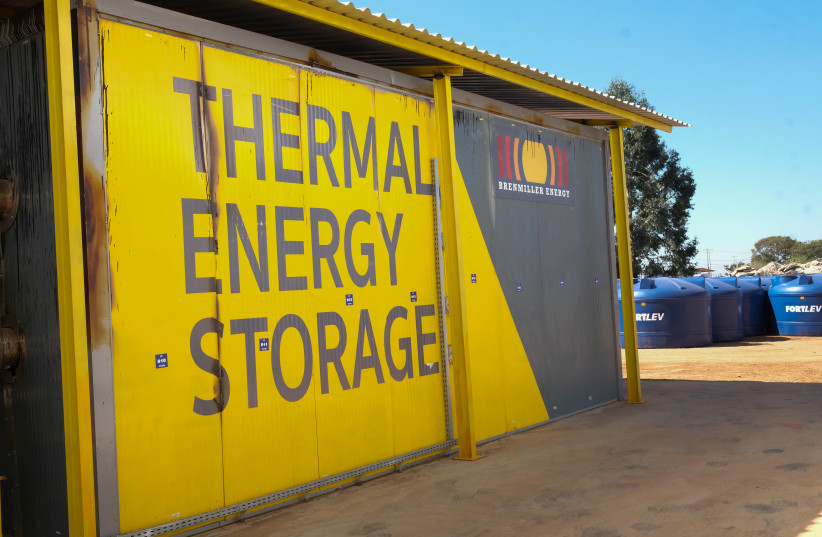
An Israeli Hospital Transitions to Green Energy, Reducing Carbon Emissions and Costs
An Israeli green energy firm has agreed to provide a Holon-based hospital with electric process heat, replacing its current natural gas-fueled steam boilers. The transition is projected to reduce the hospital’s carbon emissions by 3,900 tons annually and save it $1.3 million yearly in energy costs.
Approval and Project Details
The Finance Ministry approved the seven-year, $3.55 million project for Wolfson Hospital, which was first announced in August last year. The facility will purchase a Brenmiller bGen ZERO thermal energy storage (TES) system, which utilizes crushed rocks to store energy in the form of heat and dispatches low-cost steam, hot water, or hot air on demand.
Benefits of the System
The system will replace Wolfson’s outdated diesel boilers, which are both costly and polluting. “The project is expected to reduce our fuel oil consumption to nearly zero,” said Gadi Davidovitz, chief engineer at Wolfson Hospital. “It will significantly reduce emissions generated by the hospital while saving on energy costs.”
Some $450,000 of the budget will be covered by a grant from the Israel Innovation Authority.

Revolutionary Technology
“With our breakthrough bGen ZERO technology, we will provide Wolfson Hospital with a cleaner source of electricity at a lower price than its legacy systems,” said Brenmiller’s Chairman and CEO Avi Brenmiller. “Our sustainable power infrastructure will benefit all hospital stakeholders, from patients and doctors to administrators, government, and local communities.”
The Brenmiller system converts electricity into heat to power sustainable industrial processes at a competitive price with natural gas. The company’s bGen was named among TIME’s Best Inventions of 2023 in the Green Energy category.
Brenmiller said that he hopes that the installation is only the beginning of wide-scale TES adoption in Israel and that it could become the standard for clean energy storage for industrial and municipal facilities in the country and worldwide.
SDGs, Targets, and Indicators
-
SDG 7: Affordable and Clean Energy
- Target 7.2: Increase substantially the share of renewable energy in the global energy mix
- Indicator 7.2.1: Renewable energy share in the total final energy consumption
-
SDG 13: Climate Action
- Target 13.2: Integrate climate change measures into national policies, strategies, and planning
- Indicator 13.2.1: Number of countries that have communicated the strengthening of institutional, systemic, and individual capacity-building to implement adaptation, mitigation, and technology transfer
- Indicator 13.2.2: Number of countries that have communicated the strengthening of capacity to mobilize domestic financial resources from multiple sources
Analysis
The article discusses an Israeli green energy firm providing a hospital with electric process heat, replacing its current natural gas-fueled steam boilers. This is connected to SDG 7 (Affordable and Clean Energy) as it focuses on transitioning to renewable energy sources. The specific target under SDG 7 that can be identified is Target 7.2, which aims to increase the share of renewable energy in the global energy mix. The indicator for this target is Indicator 7.2.1, which measures the renewable energy share in the total final energy consumption.
The article also highlights the reduction of carbon emissions and cost savings achieved through this transition. This is connected to SDG 13 (Climate Action) as it contributes to reducing greenhouse gas emissions and mitigating climate change. The specific target under SDG 13 that can be identified is Target 13.2, which focuses on integrating climate change measures into national policies, strategies, and planning. The indicators for this target are Indicator 13.2.1, which measures the strengthening of institutional, systemic, and individual capacity-building to implement adaptation, mitigation, and technology transfer, and Indicator 13.2.2, which measures the strengthening of capacity to mobilize domestic financial resources from multiple sources.
Table: SDGs, Targets, and Indicators
| SDGs | Targets | Indicators |
|---|---|---|
| SDG 7: Affordable and Clean Energy | Target 7.2: Increase substantially the share of renewable energy in the global energy mix | Indicator 7.2.1: Renewable energy share in the total final energy consumption |
| SDG 13: Climate Action | Target 13.2: Integrate climate change measures into national policies, strategies, and planning | Indicator 13.2.1: Number of countries that have communicated the strengthening of institutional, systemic, and individual capacity-building to implement adaptation, mitigation, and technology transfer Indicator 13.2.2: Number of countries that have communicated the strengthening of capacity to mobilize domestic financial resources from multiple sources |
Copyright: Dive into this article, curated with care by SDG Investors Inc. Our advanced AI technology searches through vast amounts of data to spotlight how we are all moving forward with the Sustainable Development Goals. While we own the rights to this content, we invite you to share it to help spread knowledge and spark action on the SDGs.
Fuente: jpost.com

Join us, as fellow seekers of change, on a transformative journey at https://sdgtalks.ai/welcome, where you can become a member and actively contribute to shaping a brighter future.






